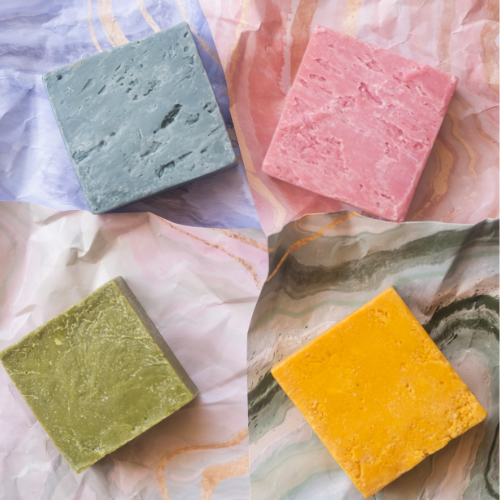Blogs + Announcements
How to Color Soap Naturally: Clays Botanicals and Micas
How to Color Soap Naturally: Clays Botanicals and Micas
Adding natural colorants to handmade soap enhances its visual appeal while keeping it free from artificial dyes. Whether you’re a beginner or an experienced soap maker, using natural clays, botanicals, and micas can create beautiful, skin-friendly soaps. In this guide, we’ll explore the best natural soap colorants and how to use them effectively.
1. Clays to Color Soap Naturally
Clays are popular in soap making because they add color while offering skin benefits like oil absorption and gentle exfoliation. Here are some top choices:
- Kaolin Clay (White Clay) – A mild, creamy white color suitable for all skin types.
- French Green Clay – Adds a soft green shade and is great for oily skin.
- Rose Clay (Pink Kaolin Clay) – Creates a beautiful pink hue while gently detoxifying the skin.
- Bentonite Clay – Light gray to beige color, ideal for deep cleansing bars.
- Brazilian Purple Clay – Offers a lavender hue while providing skin-nourishing minerals.
How to Use: Mix 1 teaspoon of clay with a small amount of water or oil before adding it to your soap batter.
2. Botanicals for Natural Soap Coloring
Botanical ingredients not only color soap naturally but also provide therapeutic benefits. Here are some of the best botanical colorants:
- Turmeric Powder – Produces a warm golden yellow with antioxidant properties.
- Spirulina Powder – Creates a deep green shade and is rich in nutrients.
- Activated Charcoal – Gives soap a striking black color while drawing out impurities.
- Hibiscus Powder – Provides a pink to mauve shade and is great for sensitive skin.
- Alkanet Root Powder – Yields shades from light pink to deep purple, depending on pH levels.
How to Use: Add ½ to 1 teaspoon of powdered botanicals per 500g of soap batter. For stronger color, create an infusion by steeping the powder in oil before use.
3. Micas for Vibrant and Shimmering Colors
Micas are naturally occurring mineral-based pigments that add vibrant color and a shimmering effect to soap. They come in a variety of shades, including blues, purples, pinks, and metallic tones.
- Gold Mica – Adds a luxurious golden shimmer.
- Pearl White Mica – Creates a soft pearlescent glow.
- Teal Mica – Produces stunning ocean-blue shades.
- Berry Pink Mica – Provides a rich, feminine touch to soaps.
How to Use: Mix 1 teaspoon of mica with 1 tablespoon of lightweight oil (such as sweet almond or grapeseed oil) before adding it to your soap batter. Micas work best in melt-and-pour and cold-process soaps.
Tips for Using Natural Colorants in Soap Making
- Test Before Use – Some natural colorants change shades over time or during the curing process.
- Use Dispersing Agents – Mixing powders with oil or water prevents clumping.
- Combine Colors – Layer or swirl different natural colorants for artistic effects.
- Adjust for pH Sensitivity – Some botanicals, like alkanet root, change color based on the soap’s pH level.
Final Thoughts – How to Color Soap Naturally: Clays Botanicals and Micas
Coloring soap naturally is an exciting way to create stunning, chemical-free products. Whether you choose clays, botanicals, or micas, each ingredient brings unique beauty and skin benefits to your handmade soaps. Experiment with different combinations to craft one-of-a-kind bars that are as nourishing as they are beautiful.
Want to get started with natural soap colorants? Browse our collection at Fun With Soap for high-quality clays, botanicals, and micas!

